Category Archives: Skin Care
“I would rather be late than arrive ugly.”

My mornings often feel like a race against the clock. Get up (okay, I admit I snoozed maybe once or twice), hurry up, and go. With the frantic rush to get out the door or get on the early Zoom meeting, I find myself rushing my morning routine. But there are personal hygiene and some beauty routines I just can’t skip, especially now that I’m older. It seems like, with age, it takes longer and longer for me to primp to look good.
I’m sure a lot of women – wives, mothers, professionals, etc. – feel the same way I do. But just because you are crunched for time, doesn’t mean you have to sacrifice looking gorgeous. So, I gathered a few beauty shortcuts of my own and from my always impeccably groomed clients to keep you looking pretty in no time.
BODY
- Shower the night before.
- Shave the night before to cut your shower time in half the next day. But if you shave in the morning, use an oil-based gel instead of your typical shaving cream. It will give you an easy shave while also moisturizing your skin so you can skip putting on lotion afterwards.
- If you skip the shower, use a damp cloth on the areas where smells tend to gather (a.k.a. your pits) and don’t forget the deodorant and perfume to stay fresh all day!
FACE
- Early morning mask treatments – when you first get out of bed, splash your face with tepid water and apply both an eye and face mask. (Keep the eye mask in the fridge for extra de-puffing benefits). Then you can go about your normal early morning rituals and be getting a mini facial at the same time.
- Simplify your make-up routine – Moisturizer, mineral powder with SPF, and lipstick.
- Skip the foundation. Dab concealer under eyes, down the bridge of the nose, on your chin, and on any problem areas like dark spots or pimples.
- Get a lash perm and lash and brow tinting – tint lashes and brows every month to save using mascara and eyebrow pencils. Lash perms are also great and can last for up to six weeks.
- Smudge eyeliner for an instant smokey eye – simply line your eyes using a creamy eyeliner and smudge with your ring finger. In just a few seconds, you’ll have a simple Parisian look.
- Use a tinted lip balm for blush – dab a tinted lip balm on your cheeks and blend for a creamy blush alternative.
- Choose a lip stain – one quick pat on the lips in the morning as you’re running out the door, and you don’t need to re-apply throughout the day.
HAIR
- Apply dry shampoo before your head hits the pillow at night. The shampoo will work itself into your strands overnight, resulting in clean, healthy-looking hair in the morning.
- Use silk pillowcases to prevent messy morning hair and keep your strands smooth while you sleep.
- Have a manageable cut that matches your hair type – straight or curly – saves having to fuss or curl.
- For bouncy beach waves, braid your hair after your shower at night and leave them in while you sleep. In the morning, undo the braids, spritz the resulting waves with a little texturizing spray, and scrunch with your hands.
- Wear your hair in a nice ponytail, braid, or bun.
- And, hats, hair pieces, and hair ties are all great accessories to have on hand.
NAILS
Dry nail polish fast with ice water. If you’re going to an event or getting ready for a date, and you didn’t have time for a mani, soak your freshly painted nails in a bowl of ice water for a minute; the cold will dry them quickly.
CLOTHING
- Choose your outfit the night before, this includes accessories like jewelry, shoes, bags, belts, etc.
- Steam your clothes in the shower to get rid of wrinkles. Hang the wrinkled clothes from the shower rod. Then go about your normal bathroom routine. Fifteen minutes later, wrinkle-free clothes.
So, even when you just rolled out of bed, no one will have to know.
For more beauty and skincare tips, check out our blogs, call us at Skinsense Wellness (323) 653-4701 or email us at skinsense@skinsensewellness.com. And for skincare services, please visit us at 8448 W. Third Street, Los Angeles, CA 90048. We will be happy to see you.
First God created man, then he had a better idea…

What’s the difference between men and women… besides our genitals, of course? It’s pretty interesting how, biologically speaking, we all start out as women. So, you’re a little embryo – a little fetus, and around 5 – 6 weeks if you have a Y chromosome it develops, and you start making testosterone and sexually differentiate.
However, the differences between male and female skin only emerge from puberty and onwards. These variations determine the type of skincare routine and products one should use, so let’s compare…
Skin Thickness
Dermatologists have found that the male dermis is about 20% thicker than a woman’s and that is why men tend to have fewer superficial fine lines than women. But they are more prone to the deep wrinkles that are caused by repeated facial expressions. Frown and smile lines for example.
Collagen and elastin production
Both men and women have specific hormones which help promote collagen and elastin production. Testosterone in men and estrogen in women. Collagen and elastin are proteins that act as the main building blocks in the skin, keeping it tight and firm.
As we age the level of both proteins diminishes. While this process happens to both men and women, they taper off at different rates. Men lose collagen and elastin at a constant rate throughout their adulthood, but gradually. Women start losing both less quickly until they hit menopause, and then the loss happens very rapidly and results in thinning, saggy skin, and wrinkles.
Oil levels and pore issues
Sebum, the skin’s natural oil, helps hydrate the skin and mixes with fat molecules to form a protective coating on the skin, defending it from harmful pathogens and bacteria.
But too much of a good thing can become a problem. Men have more oil glands or sebaceous glands than women. In fact, it has been estimated that men produce twice as much sebum than women overall. They also have larger and a higher number of pores. This combination can result in clogging and lead to acne.
Shaving doesn’t help either. It exacerbates the skin surface and can cause irritation, ingrown hairs, and even more breakouts – particularly if the beard growth is heavy and curly.
Impact of lifestyle choices on skin
Although genes play a role in how we age as a whole, our lifestyle choices can also have a powerful effect. Unfortunately, men often engage in behaviors that can speed up skin aging.
Exposure to UV rays is a primary cause of premature wrinkles in both men and women. However, men are more likely to work outdoors than women and spend long periods of time in the sun without protection – sunscreen and hats for example.
Bad habits like smoking, not getting enough sleep or exercise, and poor diet can factor in too.
Finally, men generally lack the same skin care knowledge that women are taught from an early age. This gives them a significant disadvantage in preventing wrinkles and in recognizing the signs of aging.
Skincare Advice for Men
To keep your skin in the best possible condition, cleanse every morning and evening with a non-irritating product suitable for your skin type. Keep your skin moisturized and if it is oily choose a non-greasy face lotion which will keep your face feeling hydrated all day without causing blocked pores.
If you have a beard covering part of your face, it’s especially important to keep the skin underneath it properly hydrated. Dryness under the beard can be uncomfortable, resulting in itchy, flaky skin, and even beard dandruff.
Skincare Advice for Women
Every good skincare routine starts with washing your face using a cleanser that offers gentle exfoliation and anti-aging benefits — think AHA acids, plant-derived enzymes, or even fermented ingredients. Then use an antioxidant serum containing a cocktail of vitamins — most popular are vitamin C, vitamin E, ferulic acid, resveratrol, and niacinamide —to guard against free radical development that causes degradation of precious collagen.
For moisturizers, look for a formula that contains hydrating ingredients like ceramides, hyaluronic acid, squalene, and glycerin. These formulas will replenish skin and lock in hydration for the day.
A good eye cream that depuffs and hydrates the eye area, and a collagen-boosting product like a peptide cream or growth factor serum are also great additions to a morning skincare routine.
Lastly, for both men and women, apply sunscreen. A mineral SPF of at least 30 with zinc oxide and antioxidants to support protection against environmental pollution.
For more skincare and wellness tips, call us at Skinsense Wellness at (323) 653–4701, or email us at skinsense@skinsensewellness.com. And for skincare services, please visit us at 8448 W. Third Street, Los Angeles, CA 90048. We will be happy to see you.
“In a rose, all love stories fit, and in a love story the air smells of roses” – Efrat Cybulkiewicz
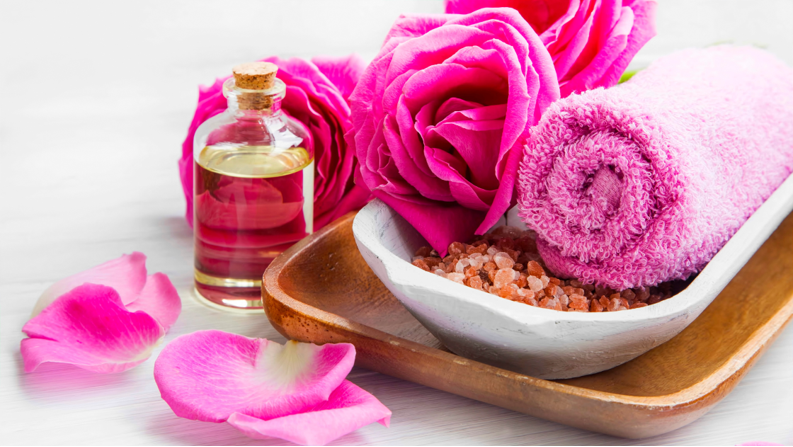
Legend has it that Cleopatra would bath in a mixture of rose water, milk and honey to keep her skin soft. She was obviously on to something because she was famous for her great beauty, and of course her power. Fast forward 2000 years, and the rose is still all the rage in skincare, beauty and wellness treatments.
Recognized for its anti-inflammatory and antioxidant properties, it’s no surprise that it has become an increasingly popular ingredient in skin care products. Rose oil contains a variety of vitamins, antioxidants and minerals and is fantastic for tackling a multitude of skin issues.
There are two main types of rose that are valued in the cosmetic industry: the Damask Rose (Rosa damascena) and the Cabbage Rose (Rosa centifolia). Damask roses are the preferred variety for their sweet fragrance, their potency against bacteria and anti-aging compounds. But essential oils from both of these have distinct benefits for our skin and wellbeing.
Skin protection
Rose contains a number of powerful antioxidants that fight free radicals. This helps to strengthen and protect skin cells from environmental damage, and regenerate skin tissue.
Skin hydration
While rose is great for all skin types, it is especially suited to treat dry and aged skin due to its extremely hydrating properties. Used on its own, or under a moisturizer in the form of an essential oil or serum, rose extract strengthens the skin barrier and seals in moisture.
Antiaging properties
Two of the antioxidants found in rose oil arevitamins A and C, both of which can help with aging skin. Apart from smoothing the appearance of fine lines and wrinkles, these vitamins help to reduce the appearance of age spots and aid with collagen production. Vitamin C also helps to protect the skin from UV exposure.
To soothe skin irritation
Rose oil is widely used for its calming benefits. It soothes redness and rosacea and any surface itchiness or irritation. Rose hip oil, in particular, contains fatty acids which are ideal for treating inflammatory conditions, including eczema and psoriasis.
Heals cuts, scars, and burns
Rose water has antiseptic and antibacterial properties which can help fight infection and heal wounds and burns faster.
Hair moisturizer
If you have dry, frizzy hair, especially in the wintertime, a few sprays of rose water can help tame your mane.
Mood enhancer
Because of its very pleasant and calming smell, rose oil can be used in a room diffuser to help boost self-esteem, confidence and mental strength as wells as diminish feelings of anxiety and depression.
Here’s how to use it:
Rose essential oil is expensive and potent. A small amount goes a long way and blends well with jojoba oil, grapeseed, sweet almond and argan oil.
For your bath: Add about 5-7 drops of rose oil to a carrier oil of your choice and then add the mixture to your warm bath for a relaxing experience.
As a soak for your foot: Add 4-5 drops of rose essential oil to warm water and soak your feet in it.
For anxiety relief: Diffuse rose essential oil for calmness or you can also dab some diluted rose oil on your wrists, neck, and chest.
While rose water can be used in a number of different ways:
As a facial cleanser or toner: Just rinse your face with rose water after washing with your regular cleanser.
As a skin mist: Put rose water in a spray bottle and mist on your wrist, face, or even your pillow.
(Rose water and rose essential oil are used in aromatherapy to help relieve headaches this way.)
As a refreshing drink: Add to regular water for tastier hydration or mix in lemonade, iced tea and other drink recipes.
Suffice to say that stopping to smell the roses (along with dabbing, slathering, soaking, etc.) truly has some magical benefits.
For more skincare and wellness tips, call us at Skinsense Wellness at (323) 653–4701, or email us at skinsense@skinsensewellness.com. And for skincare services, please visit us at 8448 W. Third Street, Los Angeles, CA 90048. We will be happy to see you.
“Why yes, they are my lashes… I bought them.”
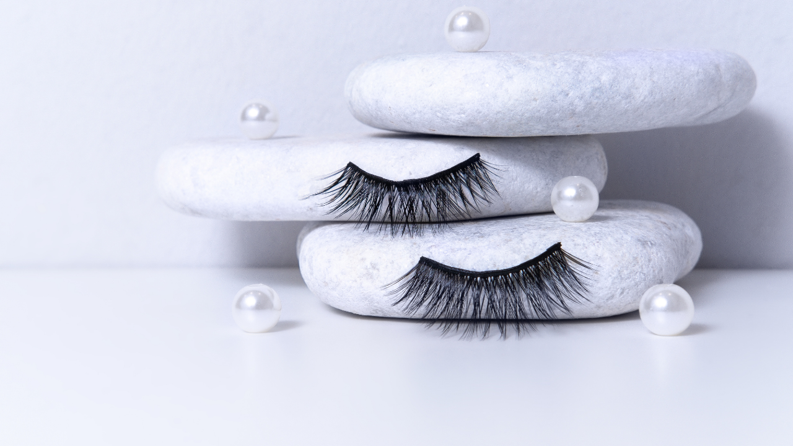
Long, dark lashes have long been associated with beauty throughout history. From as early as 4000 BC, women in ancient Egypt took to emphasizing their eyelashes with kohl and other ointments. This rudimentary eye makeup not only accentuated the eyes, but it also served as extra protection from the sun. A few thousand years later, Roman women also used kohl to darken their eyelashes. At the time, long, full eyelashes were seen as a sign of chastity. That’s right… it was actually believed that a woman’s eyelashes would fall out if she had too much sex.
In today’s world, we have mascara and eyeliner to give them that extra lift. And admit it, Kim Kardashian’s perfect eyelashes just make you green with lash envy. And, you know what? I don’t blame you. Long, full eyelashes are every woman’s dream, me included. They amplify the eyes and produce a feminine sultry vibe that many women want.
So, get ready to bat an eyelash, here’s everything you need to know about our favorite facial hair.
Lash facts
The focus on eyelashes is often for their aesthetic beauty. But eyelashes also serve a critical function in eye safety. They are the first line of defense for your eyes, keeping airborne dirt, dust, lint and other debris from reaching the delicate eye tissues.
With eyes open, eyelashes catch some airborne debris, but when closed, eyelashes form a nearly impenetrable barrier against foreign irritants in the eye.
The lash itself is composed of the shaft and bulb which connects to the blood vessels around the eye and has a life cycle of between 4 and 11 months. The lower lid typically has between 75 to 80 lashes in four rows, while the upper lid has between 90 to 160 lashes in five or six rows.
Healthy eyelashes can grow to around 12 millimeters and although they are meant to have a slight curvature, they can very often grow straight out or in odd directions.
What causes damage to our lashes? No, contrary to what ancient Romans believed, too much sex is not one of them.
- Not removing makeup at night before going to bed. Use a proper eye makeup remover, not your usual facial cleanser, and be gentle. Dab your eyes rather than rubbing and scraping them.
- Irritating or drying makeup ingredients. Use good quality cosmetics and pay attention to the shelf life of each product. And remember to change you pencils, liners and mascara every six months.
- Makeup allergies. If your eyes tend to be sensitive or you suffer from allergies, use hypoallergenic or clean makeup to reduce the chances of irritation.
- Forceful use of eyelash curlers. Use lash curlers occasionally. For a more gentle approach, use an eyelash comb every day.
- Overuse of false eyelashes and rough removal techniques . To remove false eyelashes, soften any adhesive with eye makeup remover. Pinch the outer edge of the false eyelash strip and gently pull away from the lash line. And keep your reusable false lashes clean by removing any lingering adhesive with a makeup remover.
How do you properly care for your lashes?
- Brushing them daily would be a big help if you would rather not use mascara but still want your lashes to look long and full naturally. Use a clean and soft bristle mascara wand and be careful not to brush too harshly or for too long as this could cause them to fall out.
- Moisturize lashes with vitamin E, castor, coconut, or almond oil to keep them soft, pliable and fuller looking. Apply with a clean mascara wand or a cotton ball before sleeping and just rinsing the conditioning treatment in the morning.
- Invest in an eyelash serum. Used daily these serums not only maintain the health of the lash but promote growth.
- Take breaks from wearing any eye makeup and false lashes whenever you can.
- Making a few changes to your diet can dramatically improve the health of your eyelashes, along with your skin and your hair. Make sure you’re eating enough protein, leafy greens, and healthy fats to support healthy hair growth. You may also want to consider supplementing with Biotin and vitamins C, D, E and H. These are extremely helpful in keeping your eye lashes full and healthy.
While mascara, of course, is still one of the most popular beauty products out there, it isn’t the only beauty product/treatment available to those looking to boost their lashes. Eyelash technology has evolved to also include semi-permanent extensions, growth serums, eyelash tools and more.
Here are some of the popular eyelash products, treatments and technology to try out:
- Eyelash primer – a no flake peptide formula with mini fibers that hang on to your natural lashes. It preps and boosts the lashes so they appear much longer when paired with mascara.
- Lash extensions – these are semipermanent lashes that are hand-glued on top of your natural lashes. Eyelash extensions, when properly cared for, can last for 6 – 8 weeks until they fall out like your natural lashes. Your lash stylist can then fill in the missing pieces at this time or earlier if you want to wear them indefinitely.
- Lash Lift – it’s a 45-minute procedure where an aesthetician will use an adhesive and a curling tool to press your own eyelashes up, basically perming them, to make them look longer and thicker. Make sure the glue used contains butyl cyanoacrylate and octyl cyanoacrylate instead of formaldehyde—they’re less toxic to the eye area and lashes. When done properly the results can last for up to six weeks.
- Eyelash Tinting – uses a semi-permanent dye on the lashes that works similarly to hair color and will fade after 2-4 weeks. The dye reveals darker lashes and makes them appear naturally longer and fuller without mascara.
For more lash care and skincare tips, call us at Skinsense Wellness at (323) 653–4701, or email us at skinsense@skinsensewellness.com. And for skincare and lash services, please visit us at 8448 W. Third Street, Los Angeles, CA 90048. We will be happy to see you.
“I got to get my life together. This crazy heat made me realize I can’t go to hell.”

I am very fair skinned… I mean really fair skinned. I can get sunburned wearing high SPF lotion. Yesterday, I was in the sun for five minutes loading groceries into my car. My cheeks are still reddish and warm. Suffice to say, I’m ultra-sensitive to sun and heat.
Well… the heat is on again. As a matter of fact, a brutal heat wave is scorching parts of India and Pakistan now causing health concerns, among others. Of course, climate change and global warming are to blame for the alarmingly high temperatures.
Global warming alone causes free radical damage to the skin unimaginable in the past when life was generally cooler, globally. The result on the skin is pigmentation, brown patches, and accelerated aging.
But along with global warming, we also unknowingly expose our poor skin to other heat sources causing further damage.
Certain types of exercise like hot spinning and hot yoga maybe good for the body and mind, but not always for the skin. People who do hot yoga more than five times a week are getting more discoloration and persistent redness. And wearing sunscreen apparently doesn’t seem to help.
Working in a kitchen or bakery can have the same effects too.
According to a study from Seoul National University College of Medicine, just 30 minutes of heat exposure three times a week for six straight weeks is enough to change your skin. It causes protective antioxidant levels in the skin to drop and genes to create MMP or Matrix Metalloproeinases. These are proteins that break down collagen and elastin, causing wrinkles.
Heat also triggers melanocytes, the pigment-producing cells within our skin. MMP’s and melanocytes both have positive roles to play in protecting the skin from damage and keeping it healthy, but when over stimulated by heat, they can be very damaging. And heat, when experienced regularly, can penetrate as deeply as the sun’s rays.
What’s more? If you’re Asian, African American, or Latina, susceptibility to hyperpigmentation is genetic. Excessive heat just adds fuel to that fire.
But enough of the bad news already… now that you know how bad heat can be for the skin, you can always reduce your exposure – less of that hot spin and hot yoga classes.
If, however, getting exposed to heat cannot be avoided, here’s a few things you can do to protect your skin:
- Use mineral-based sunscreens and foundations that contain physical blocks like zinc oxide. They are great at fighting sun damage and heat.
- Mineral sprays used throughout the day can also keep the skin cool. Just remember to reapply sunscreen.
- Refrigerate your skin treatment products like masks and moisturizing gels and use them immediately after a cool shower and exposure to heat.
- Use daily moisturizers and serums that contain copper, magnesium, selenium, radish root and niacinamide. And of course, those powerful antioxidants – C and E.
Finally, don’t forget to wear a good strong deodorant. The last thing you want to be worrying about is odor from the heat sweats.
For more skincare tips, visit our website, call us at Skinsense Wellness at (323) 653–4701, or email us at skinsense@skinsensewellness.com. And for skincare services, please visit us at 8448 W. Third Street, Los Angeles, CA 90048. We will be happy to see you.
“Hot one minute, then freezing the next. I’m pretty sure spring is a woman.”

The cold never bothered me… just kidding. I’m so glad that winter is finally over, and Spring is here! It’s nice to be able to spend more time outside – the weather is nice and warm, flowers are abloom, the grass is greener, and the air is fresh.
It’s also perfect skin season, after the dry, flaky winter and before greasy, sweaty summer… eew! However, beautiful spring skin doesn’t just happen with the change of season. It takes time, effort, commitment, and a change of regimen.
As you would spring clean your home, you need to do spring cleaning for your skin as well – outside and inside. Here’s a few easy changes to your skincare routine for perfect spring skin.
- Start exfoliating to get that dead winter skin off, making skin brighter. For the body, do some vigorous dry brushing, followed by a good soak and scrub session in the bathtub. Then slather on a body lotion. As for the face, gently exfoliate with a gentle scrub or silicone brush that doesn’t scratch the skin surface. Also, book a light AHA/BHA enzyme treatment with your aesthetician.
- Switch to a light moisturizer. As the temperatures and humidity increase, we no longer need the heavy creams to keep our skin moisturized, and heavy products can feel sticky and greasy. Add a C serum to your morning routine then apply a light gel-based moisturizer. Choose one with hyaluronic acid (HA) for use at night to help protect the skin barrier from the allergens and pollution in the air as we indulge in more outdoor activities.
- Upgrade your SPF. Now that the weather is getting warmer, you really need to start wearing sunscreen. The earth is physically closer to the sun during warmer months, so UV rays are stronger. If you have been diligent with wearing sunscreen, even in the winter months, increase the SPF to at least 50 and make sure your sunscreen products offer broad-spectrum protection.
- Use Facial Mists. We know that drinking adequate amounts of water is important for the skin. But when you are outside, facial mists work on the skin instantly to keep it well hydrated, help it regain brightness, and remove dryness. Mists are also effective in eliminating excess sweat, keeping the skin clean and bacteria-free.
- Take supplements. Make sure you have vitamins E, C, and zinc to boost the skin’s immune system and avoid sun damage, fish or flaxseed oil capsules and probiotics for your internal immune system, and milk thistle if you want to do a gentle liver cleanse.
- Exercise. With the beautiful warmer weather, it would be nice to get outside, jog a few miles, ride your bike or swim. All this exercise and physical activity helps to get healthier, fresher, and smoother skin.
- Lighten the diet. Add the following to your grocery list: asparagus, blueberries, pineapple, grapefruit, beets, and pomegranates. All of these fruits and vegetables are loaded with antioxidants that aid digestion, give you lots of energy, and radiant skin. Cinnamon, green juice, and abstaining from alcohol also works wonders for the skin.
- Spring clean your beauty arsenal. Keep nothing that is more than six months old. Go through your skincare products, check the expiration dates, and toss accordingly. Keep in mind that even if a product hasn’t been opened, active ingredients will become less potent and less effective over time.
Make these minor Spring skincare changes along with a healthy and active lifestyle and feel your skin glowing all year long.
For more skincare tips, call us at Skinsense Wellness at (323) 653–4701, or check out my other blogs. And for skincare services, please visit us at 8448 W. Third Street, Los Angeles, CA 90048. We will be happy to see you.
“I’m still hot. It just comes in flashes.”
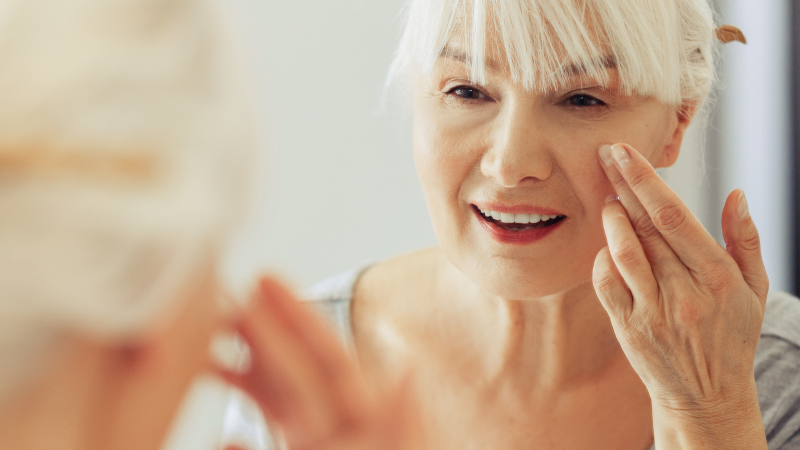
Menopause sucks! It’s depressing enough that I can’t get into my skinny jeans anymore, no matter how much I jump, wriggle, and kick my legs into them. But along with the weight gain are a multitude of other symptoms — irritability, hot flashes, unwanted facial hair, and chaos on my skin. Waah!
No wonder most women dread and worry so much about this time in their life.
During our reproductive years, the hormone estrogen helped keep our skin healthy and supple. As hormone levels plummet, our skin can exhibit Increased dryness, age spots and pigmentation, loss of tone and elasticity, acne, increased sensitivity (likely to lead to rashes and irritations) and increased bruising. Oh, what fun!
All annoying conditions but for this article I want to focus on the menopausal skin issue I get the most question about… pigmentation. If you’ve spent time in the sun (and who hasn’t by age 50?), you’ll likely see age spots and other signs of sun-damage on your face, hands, neck, arms, or chest appearing at this time.
Let’s take a look at the different types of pigmentation caused by hormonal changes.
Melasma
Also known as “chloasma,” or the “pregnancy mask,” melasma is a common pigmentation disorder that causes brown or gray patches, primarily on the face, most often seen in pregnant and menopausal women. Hormonal birth control and Addison’s disease can cause the condition too. It has even been established that intense heat, with or without sun exposure, can create this type of pigmentation on the chin, nose, upper lip, cheeks, and forehead.
Age spots
Estrogen plays a part in the regulation of melanin, the pigment that gives our skin its color and protects it from the harmful rays of the sun. During menopause the decrease of estrogen that occurs can lead to decreased production of melanin. And with lowered melanin production, our skin can become more susceptible to sun damage such as age spots, also known as sunspots or liver spots.
Pigmentation can be very difficult to get rid of. But with a combination of the right ingredients, and sun protection, great results can be accomplished.
Here are a few excellent ingredients that can help to minimize and fade these types of skin discolorations.
Vitamin C, also known as ascorbic acid, is vital for the production of collagen and elastin in the skin. It is an antioxidant, meaning it protects skin cells from damaging free radicals caused by UV exposure. By inhibiting melanin production, it helps to lighten hyperpigmentation and brown spots, even out skin tone and add radiance.
Retinol is a vitamin-A derivative that is used to treat a wide variety of skin issues, including acne and wrinkles. It’s helpful for hyperpigmentation because it encourages cell turnover and over time can thicken the skin surface.
The traditional retinol, however, can cause irritation on some skins. A newer form, Granactive retinol, can also increase cell turnover and increase the rate at which new healthy skin cells migrate to the surface without irritation. And it gives the skin the same smooth and healthy appearance.
Bakichiol is an antioxidant found in the Psoralea Corylifolia plant and is a natural alternative to Retin A. It’s not a Vitamin A derivative and does not cause any irritation so it’s ideal for those with sensitive skin.
Niacinamide, also known as vitamin B3, works as an efficient skin lightening agent because it disrupts the transfer of melanosomes, or pigment structures, in the skin cells, in essence reversing excessive pigment production in the skin.
Kojic Acid, derived from fungi and other plant-based sources during fermentation, is a highly effective skin brightener that can treat melasma, acne scars and sunspots by boosting antioxidant activity.
Arbutin is a naturally occurring derivative of hydroquinone, one of the most commonly prescribed treatments for hyperpigmentation. While hydroquinone is a highly effective ingredient, it’s also rife with side effects and can only be used under stringent medical supervision and for short periods of time.
Its gentler sister, arbutin, is considered one of the best natural alternatives. Like most lightening agents, it works by inhibiting tyrosinase — and does so with just about no reported risks.
Tranexamic Acid is a water-soluble synthetic ingredient derived from the amino acid lysine. It has demonstrated a promising ability to reverse discoloration. It’s gentle enough for sensitive skin types but must be used with oil-soluble ingredients, like niacinamide and vitamin C.
Mulberry Extract has the ability to lower melanin production that occurs as a result of UV exposure. When used as a skin lightener, mulberry extract can even skin tone.
To ensure longer lasting benefits from the above ingredients, apply a broad-spectrum sunscreen with SPF 30 or higher every day to your face, hands, neck, and any other area that clothing won’t cover, even in wintertime.
Far from being the end of life, we can find menopause to be a wonderful new beginning, one that can be lived richly, fully, and with glowing, blemish-free skin.
For more skincare tips, call us at Skinsense Wellness at (323) 653–4701, or check out my other blogs. And for skincare services, please visit us at 8448 W. Third Street, Los Angeles, CA 90048. We will be happy to see you.
“Shoutout to all the skincare products I haven’t bought yet… I’m coming for you.”
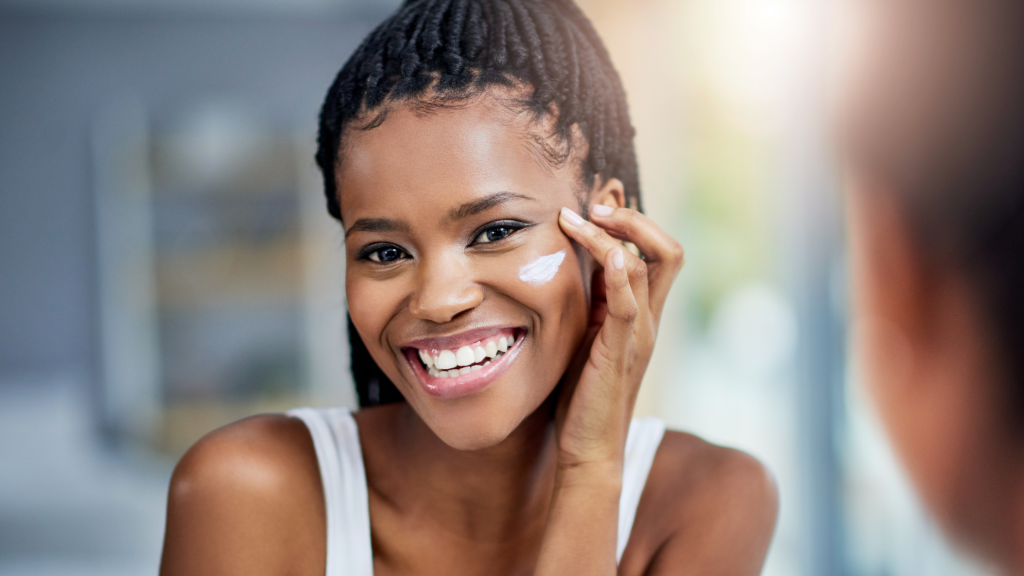
There’s something I relish about turning the calendar to January and thinking about what’s to come in the upcoming 12 months. Perhaps I’m still on a honeymoon period with the new year but there’s so much to look forward to in skincare, especially with products and approaches that can be done at home, that I can’t help gushing about them.
Here’s a few interesting new innovations that you may want to check out.
Skincare Microdosing
As its name implies, microdosing refers to using lower concentrations of active ingredients. The approach allows the skin to adapt to the benefits of the active ingredients like retinoids, AHAs, BHAs, PHAs and Vitamin C and reduce the chance of any reaction or sensitivity. When using lower concentrations over a longer period of time the skin’s barrier is kept intact and allows for a much better outcome.
This can be especially beneficial for those with sensitive skin.
Fermented Beauty
Fermentation is the process where a microbe, bacteria, or yeast is introduced to an ingredient. The procedure changes the chemical structure of the ingredient by breaking it down into the basic building blocks, which includes vitamins, essential minerals, and amino acids in their purest form. And because the molecules have been broken down, the result is smaller, more concentrated molecules that are more easily absorbed by the skin. Fermentation can also produce fruit and sugar acids which exfoliate the skin for a healthy glow.
But what’s more exciting about fermented products is their ability to help balance the skin’s microbiome — a mixture of friendly bacteria that keep the skin healthy and protected. With a balanced skin microbiome your skin is able to calm inflammation, help clear acne, eczema, and rosacea.
Blue Light protection
Blue light from the sun and all our digital devices can lead to oxidative damage in the skin which accelerates collagen breakdown and can cause fine lines and wrinkles. In addition, inflammatory hyperpigmentation of the skin is also exacerbated.
Sunscreens, filters, and using antioxidants like niacinamide and Vitamin C can help protect the skin. Besides blocking the light, blue light protection skincare also fights off free radicals formed by blue light before they can wreak havoc on your skin. Key ingredients to look for are zinc oxide, titanium dioxide, iron oxide, and antioxidants. Even products with green tea polyphenols, Coenzyme Q, resorcinol, and vitamin E would work well.
As for salon treatments to boost and keep the skin in tip top shape, nothing beats the power of the human touch. A great massage helps to stimulate circulation, reduce puffiness, and improve muscle tone. Every facial should have at least 15 minutes of massage whether it is a combination of hands, rollers, Gua sha, or lymphatic drainage. When added to a microcurrent facial, an enzyme or oxygen treatment or an AHA protocol to peel and lighten, massage makes all the difference to the efficacy of any facial treatment.
Besides, having a professional choose and apply the concentration of the more active ingredients is a much safer way to get results without any irritation.
For more skincare tips, visit our website, call us at Skinsense Wellness at (323) 653–4701, or check out my other blogs on Medium. And for skincare services, please visit us at 8448 W. Third Street, Los Angeles, CA 90048. We will be happy to see you.
“Dear past, thank you for the lessons. Dear future, let’s do this, differently.”
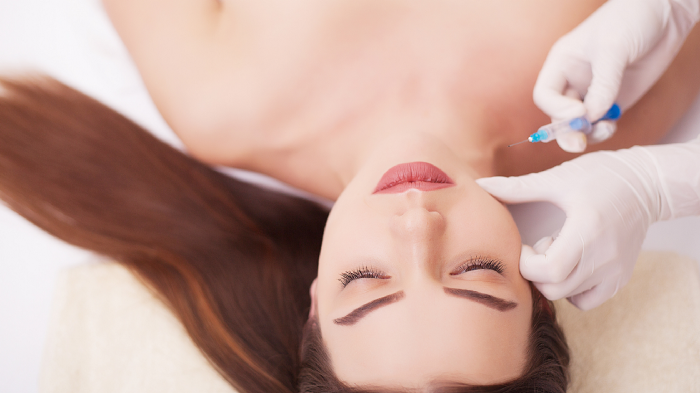
It has been a New Year’s tradition for me to look back on the accomplishments of the past year and celebrate them in order to plan ahead for the next 12 months.
So… as I was scrolling through last year’s blogs, and I’ve covered a variety of interesting beauty-related topics, I found that the articles that attracted the most attention were the ones about anti-aging. Not surprising really because that is what good skincare practices are all about.
And throughout this pandemic skincare products and treatments for the face and body have been flying off the shelves with cosmetics following suit now that we are gradually moving forward and venturing out cautiously into this new world order. In fact, plastic surgeons and dermatologists have reported 2021 as being their busiest year yet.
Suffice to say, great things are coming. No matter what we’re currently going through, there’s so much to look forward to. For everyone in the beauty industry it looks like everything’s coming up roses.
So, to kick off 2022 let’s take a look at what’s new in terms of keeping us youthful and vital at any age starting with the three new treatments in the world of dermatology that are soon to be approved and launched.
Skin Boosters
Skin boosters are injectable treatments designed for deep skin hydration and plumping. They are a blend of vitamin and enzyme injections and fillers, with a high dose of hyaluronic acid — our skin’s natural moisturizer. A hybrid of mesotherapy and filler that results in an overall glow and added hydration as well as the reduction of fine lines and wrinkles, boosters are a must for everyone’s tool box. Skin boosters can be used all over the face, neck, and chest and are compatible with all skin types.
Botox replacement — Daxi
There is a lot of buzz surrounding Daxi right now — even though it hasn’t been approved by the FDA yet and may still be renamed.
Daxi is a purified protein with 150-kidodalton toxins (a stability measurement) similar to other neurotoxins, like Botox and Dysport. The added benefit with Daxi is that it contains a proprietary peptide technology, an amino acid chain that clinical trials suggests, makes it last substantially longer with a time span averaging around 24 weeks.
While most Botox clients get injected every three months, Daxi could offer the same benefits with only two injections a year. That’s absolutely something to watch out for!
Nano-Pulse Stimulation
A new technology called NPS, or Nano-Pulse Stimulation, offers a completely new energy source that delivers very high-powered, short electric pulses to target the cells in any tissue. This technology is being used to treat everything from acne, back acne, benign moles, keratoses, warts, and potentially skin cancers more effectively. What’s more is that it’s a precise treatment that is corrective without causing any damage to the surrounding tissue.
All these new procedures have built on treatments that are proven to be effective and access the skin’s natural physiology to get results. Only this time around with added benefits for stronger efficacy and reduced adverse reactions. And isn’t that what we all want?
On my next blog, we will take a look at what’s new at your favorite professional salons and what new ingredients to add to your at-home skincare routine to accomplish the results that you are looking for.
It’s almost cliché to say it, but Cheers to the New Year and the new opportunities it brings! And here’s to younger, better-looking skin.
For more skincare tips, call us at Skinsense Wellness at (323) 653–4701, or check out my other blogs. And for skincare services, please visit us at 8448 W. Third Street, Los Angeles, CA 90048. We will be happy to see you.
“In winter my favorite outdoor activity is going back inside.”
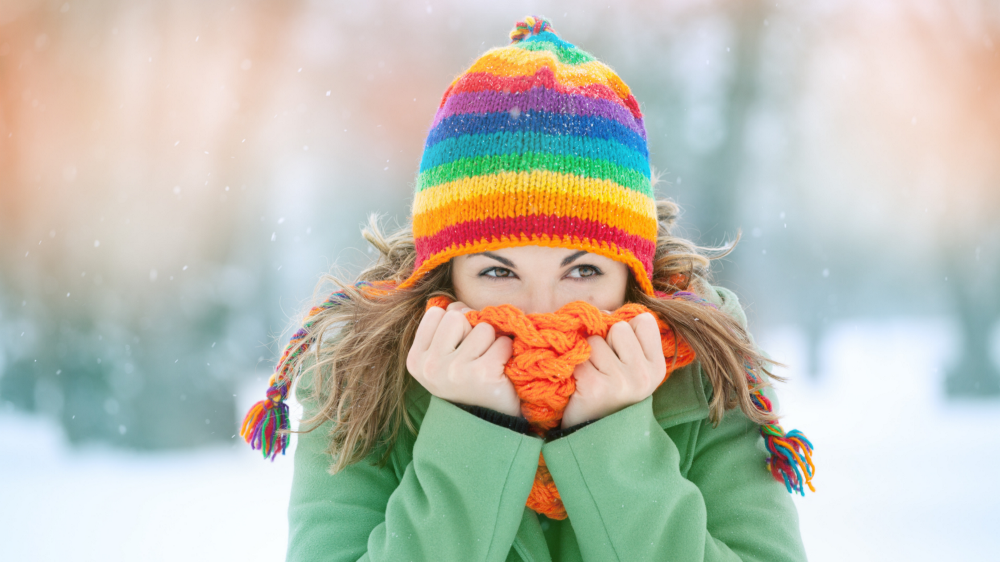
Baby it’s cold outside… No, seriously it’s freakin’ cold. And this winter weather is just wreaking havoc on my skin. Argh! The harsh, cold outside air combined with the increase in central heating (which, spoiler alert, is also bad for the skin) make it seem like I’m destined for several months of dull, dry, and itchy skin.
So, how do we take care of our skin through this cold snap, especially if you still want to enjoy your winter fun? Luckily, this year, skincare salons are open again so beyond stepping up hydration at home, we can get facials that detox, replenish, and truly rejuvenate the skin.
Here are three of my go-to treatments to avoid winter skin:
For Clean skin
Oxygen — this extensive deep-cleansing and invigorating treatment leaves pores squeaky clean, and the skin brightened and energized. Perfect for dealing with Maskne! It involves spraying highly concentrated molecules of oxygen right into the outer layer of your skin. The oxygen that’s applied to your face and neck is infused with vitamins, minerals, essential nutrients, and botanical extracts.
The addition of a cocoa enzyme, a great antioxidant, to the oxygen procedure increases circulation and results in an even more stimulating facial. At the end of the treatment, a blend of hyaluronic acid and peptides are applied to ensure that holiday glow.
For Hydrated skin
Galvanic electrotherapy — if you need a really deep moisturizing facial, this is the treatment for you. A direct galvanic current is used for infusing water-soluble substances into the skin. The soft or low-intensity electrical current (charged particles) can reach the inner layers of the skin and delivers a high level of hydration especially for those of us concerned about aging. Plus, this is a relaxing experience as the electrodes roll across those tense facial muscles. What’s more? The results of the treatment will last for days.
This procedure delivers that ageless dewy look we see on all those classic movie stars.
For Skin Tightening
Microcurrent — has the pandemic left you feeling a little saggy? This treatment introduces a gentle electric current that re-educates the muscles and gets those collagen elves working to increase production of collagen and elastin in the dermis. It offers the ultimate in tightening and firming.
It’s not the most comfortable of treatments and is best done in a series of six sessions with monthly or quarterly follow-ups. It can also be included in a full facial procedure for the first visit and really gets the skin feeling toned for the holidays.
A light application of lactic or mandelic acid can be added to any of these procedures and is suitable for pretty much any skin type. With all these skincare treatment options, you won’t need to turn on the Christmas lights to dazzle.
For more skincare tips, call us at Skinsense Wellness at (323) 653–4701, or check out our other blogs. And for skincare services, please visit us at 8448 W. Third Street, Los Angeles, CA 90048. We have re-opened our doors and are happy to welcome you all back.



